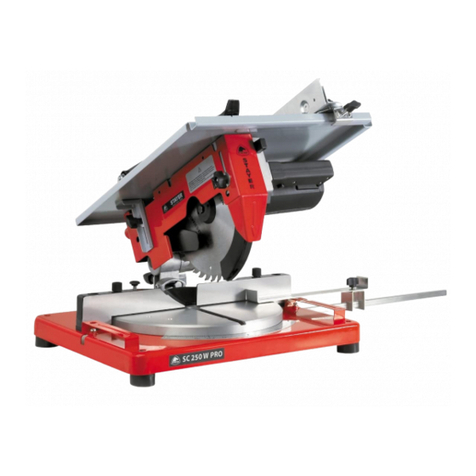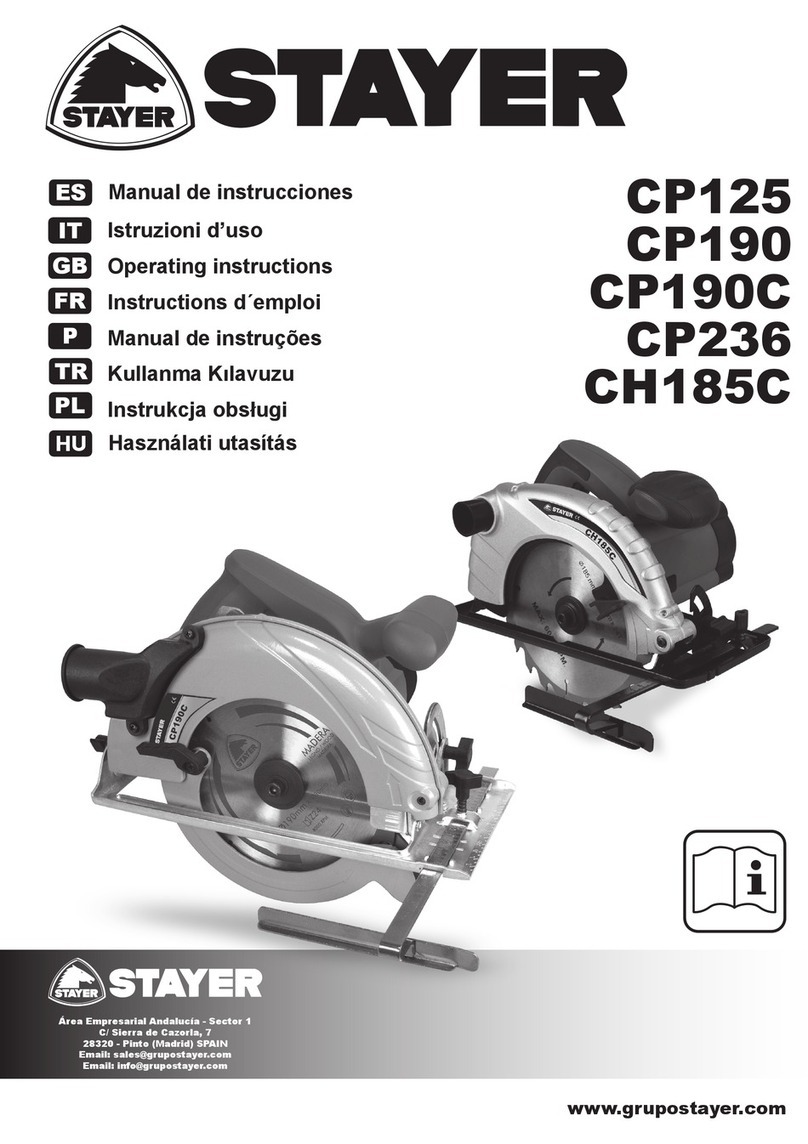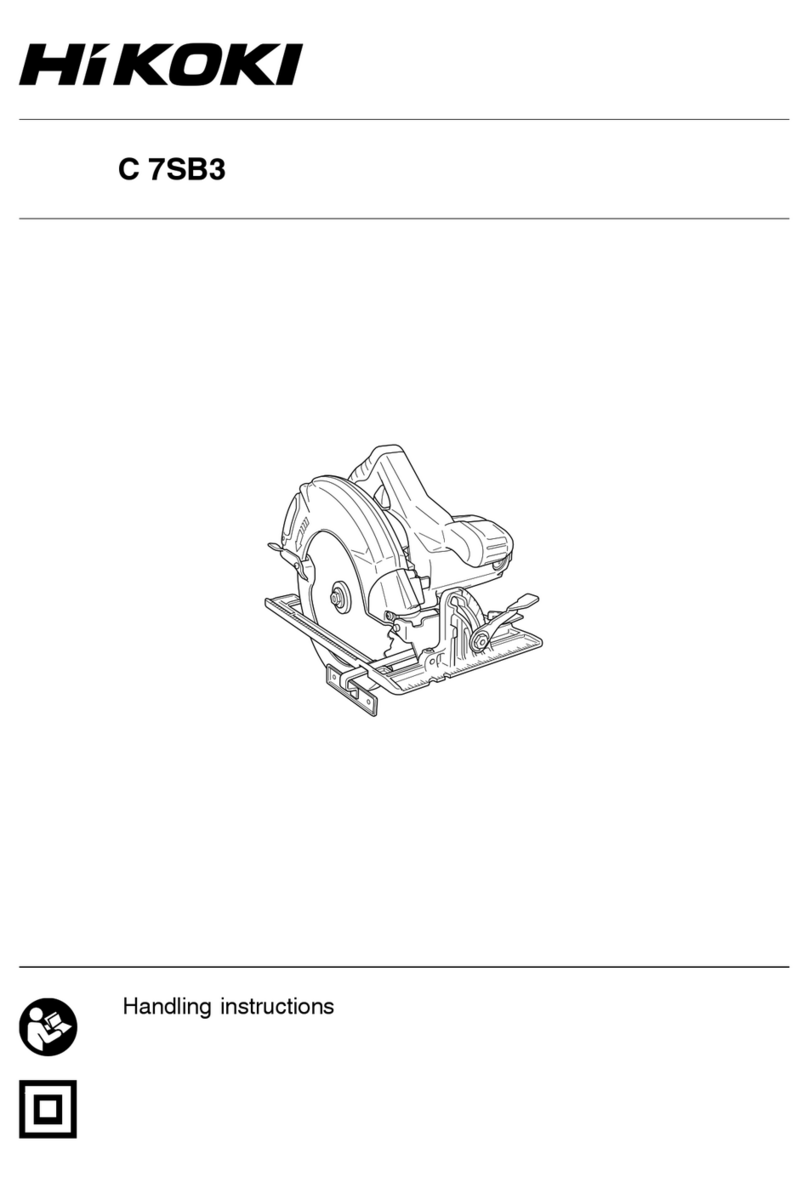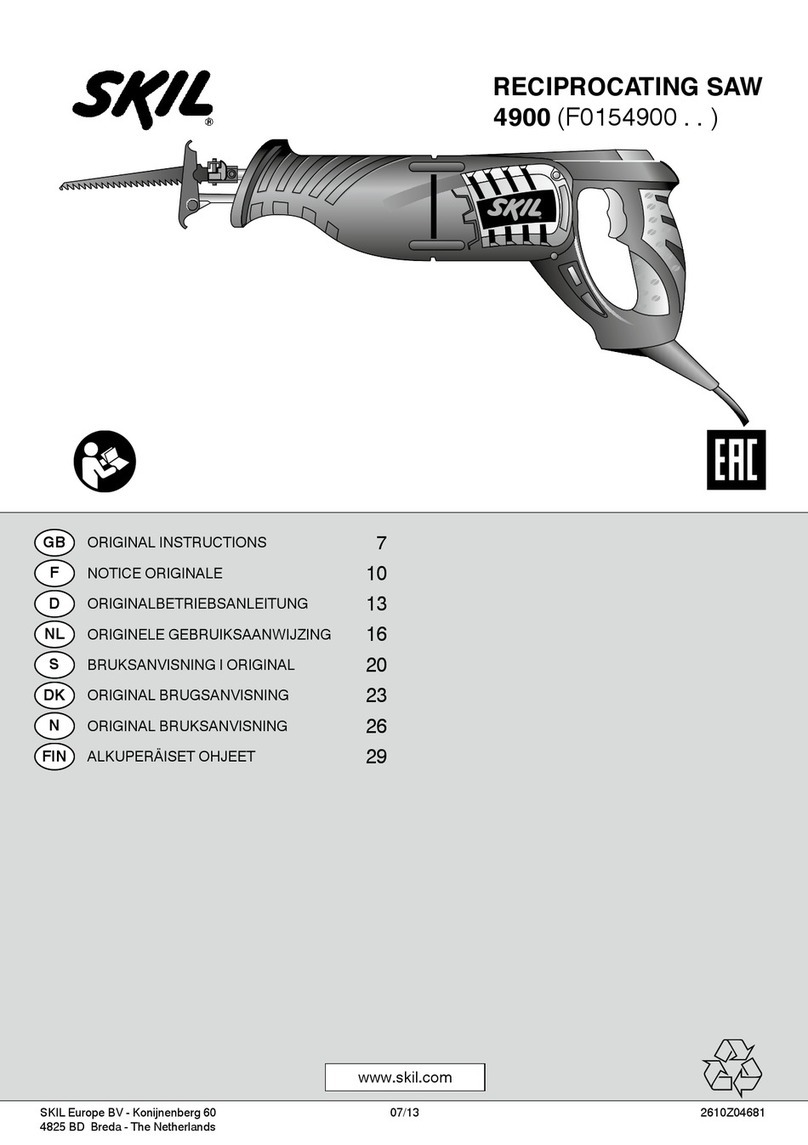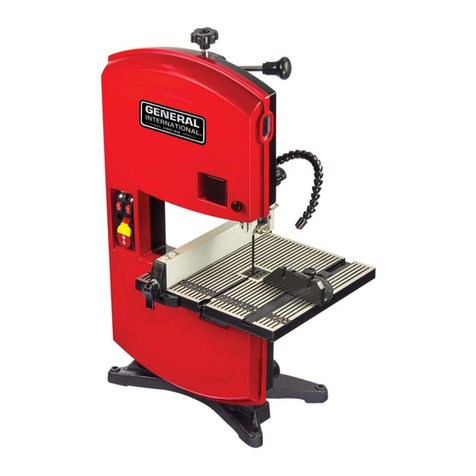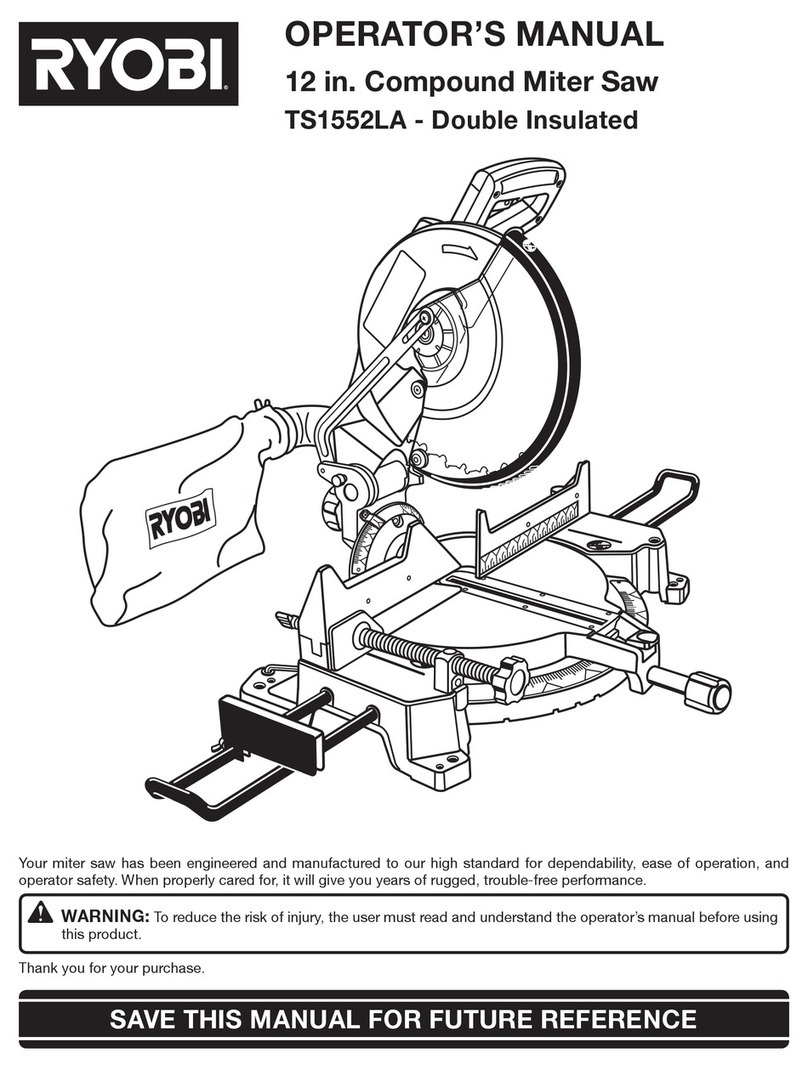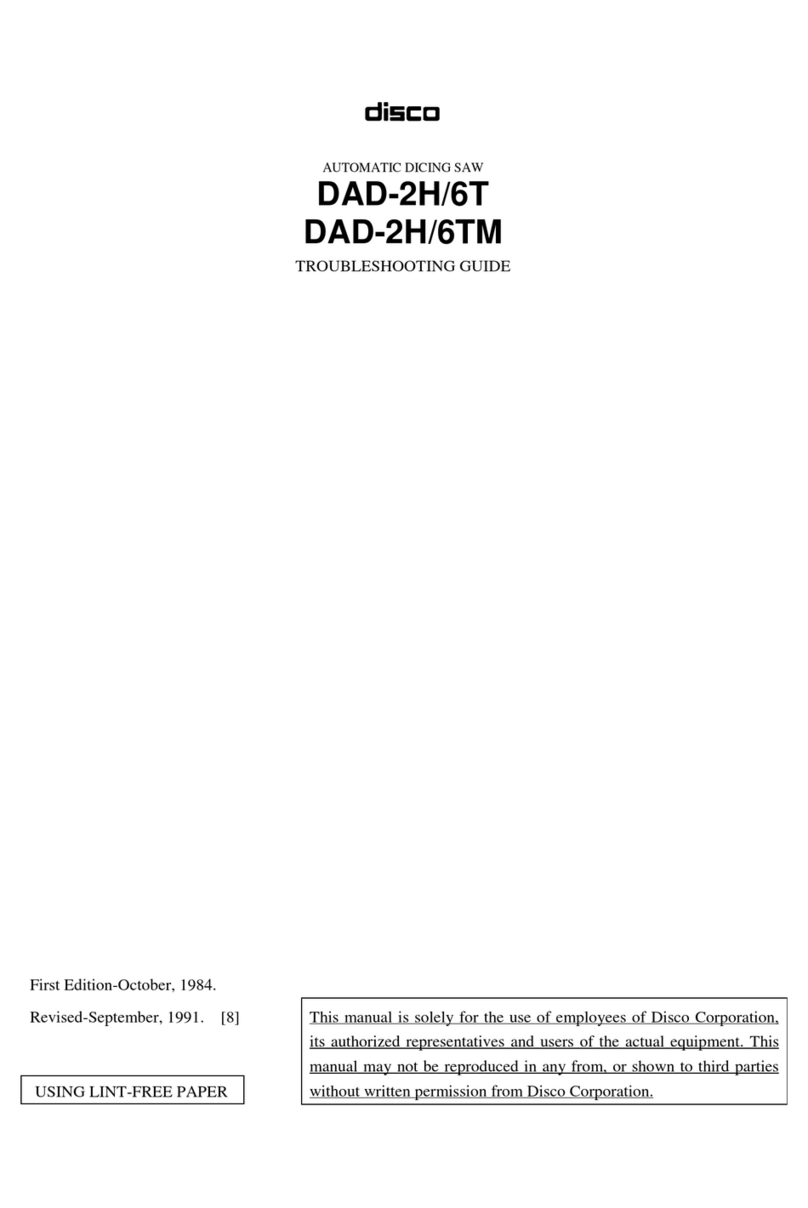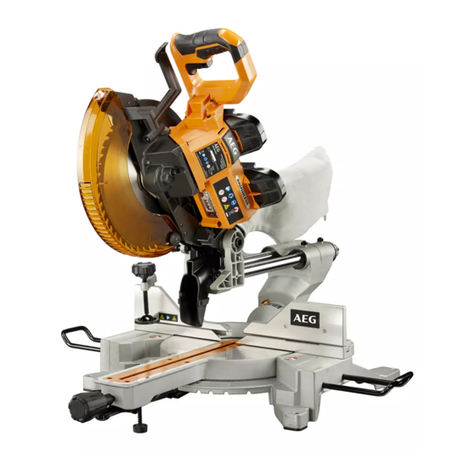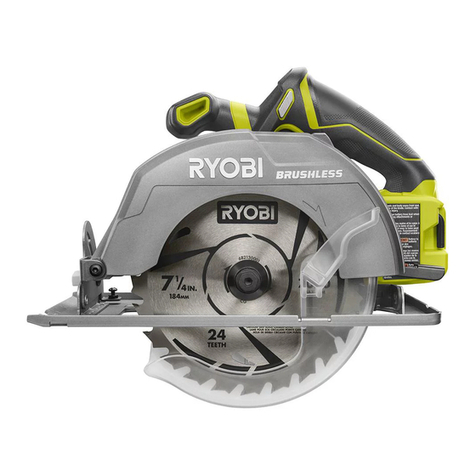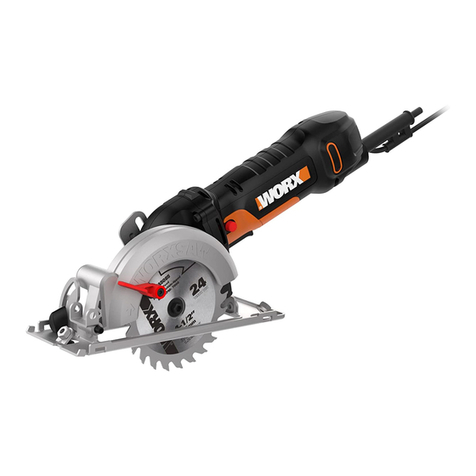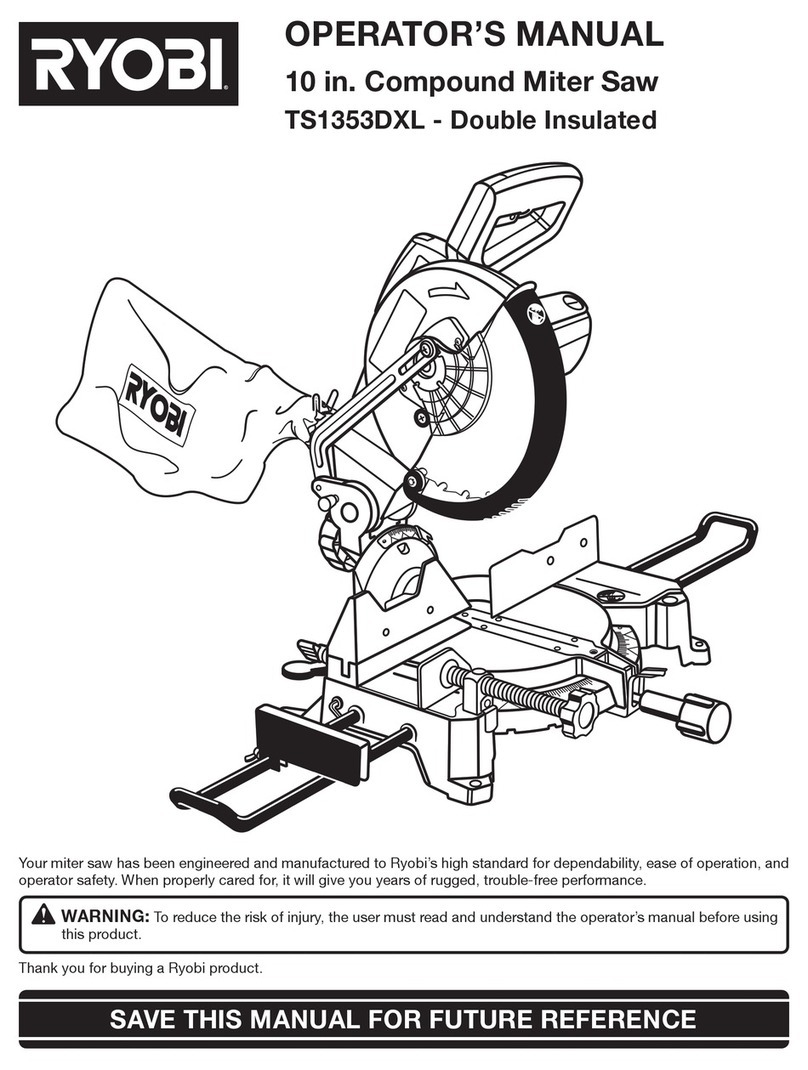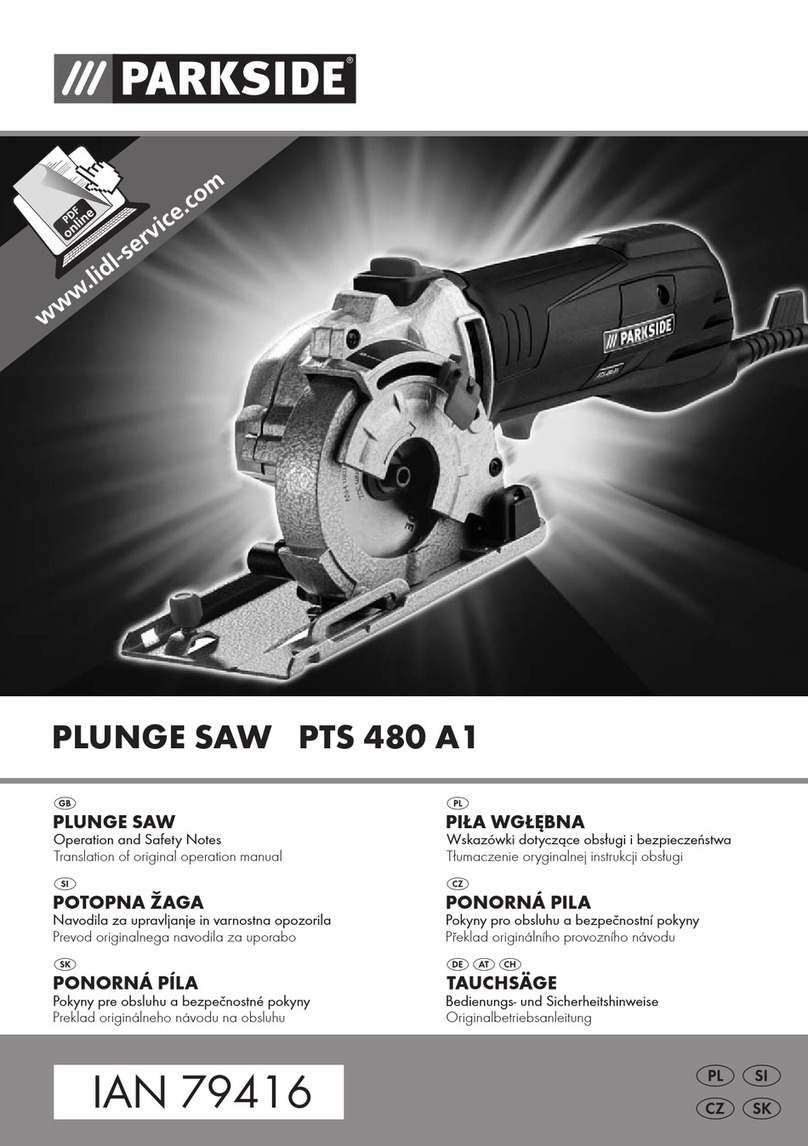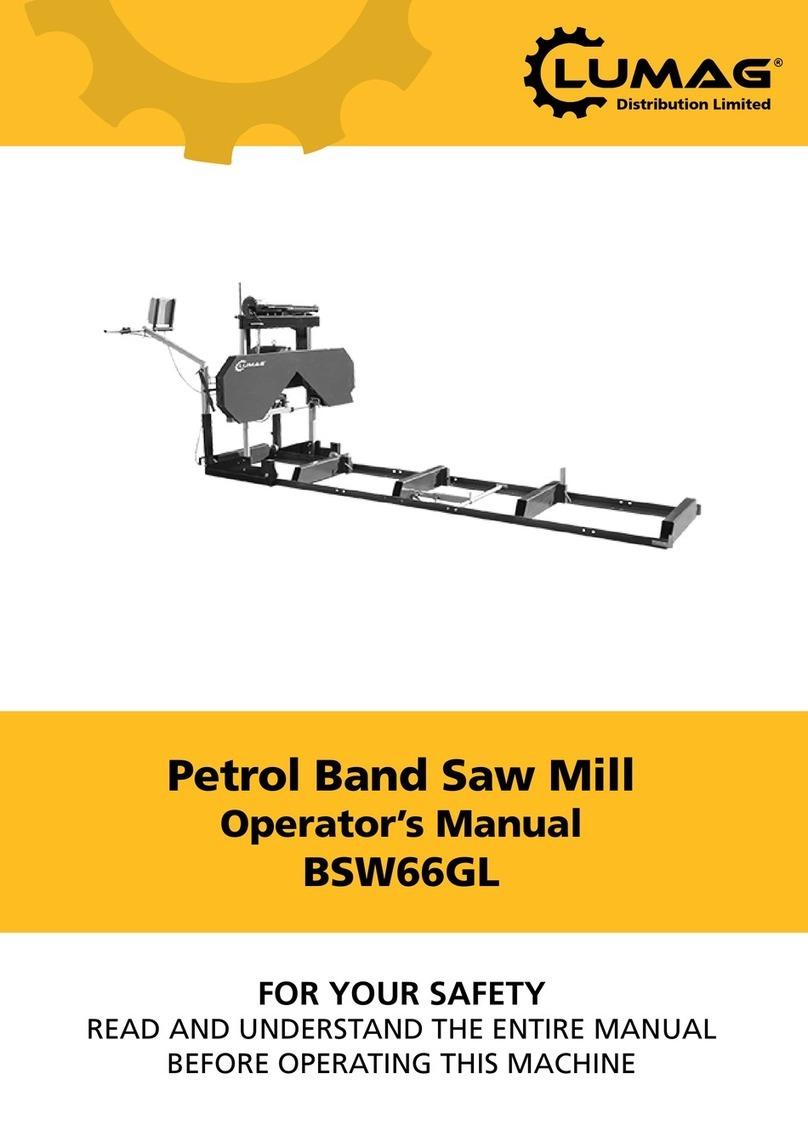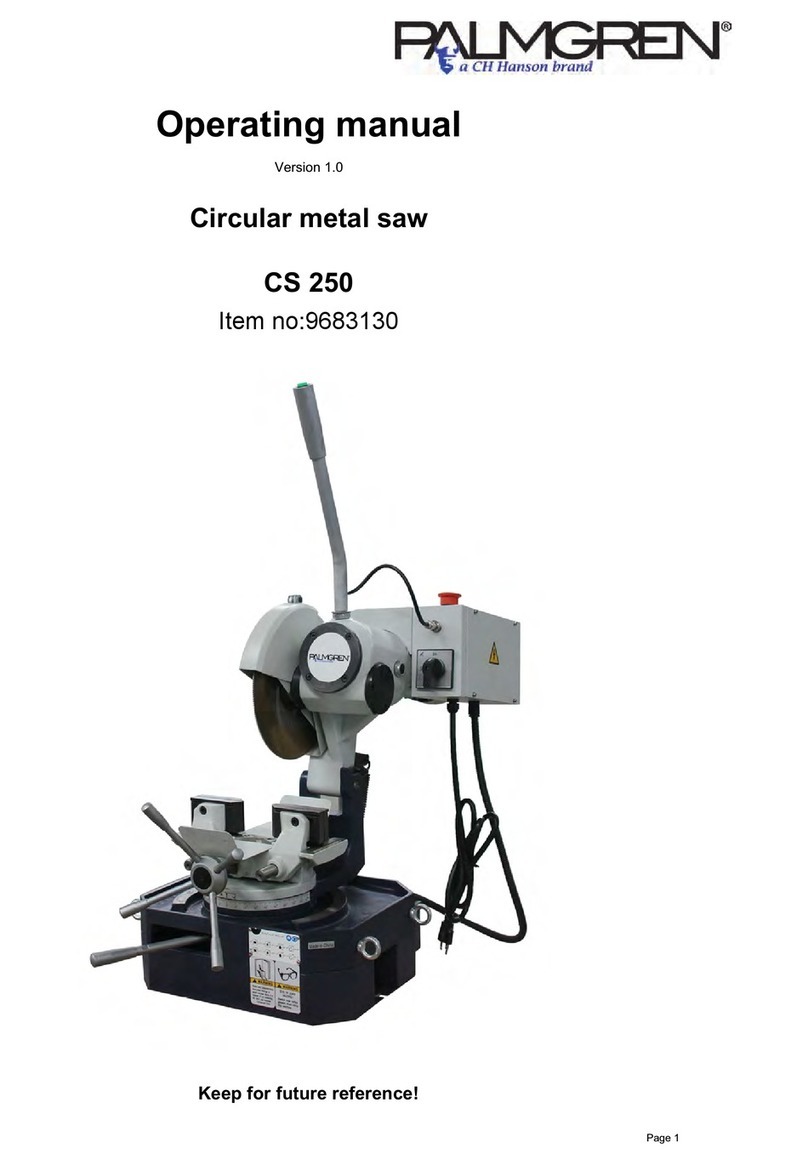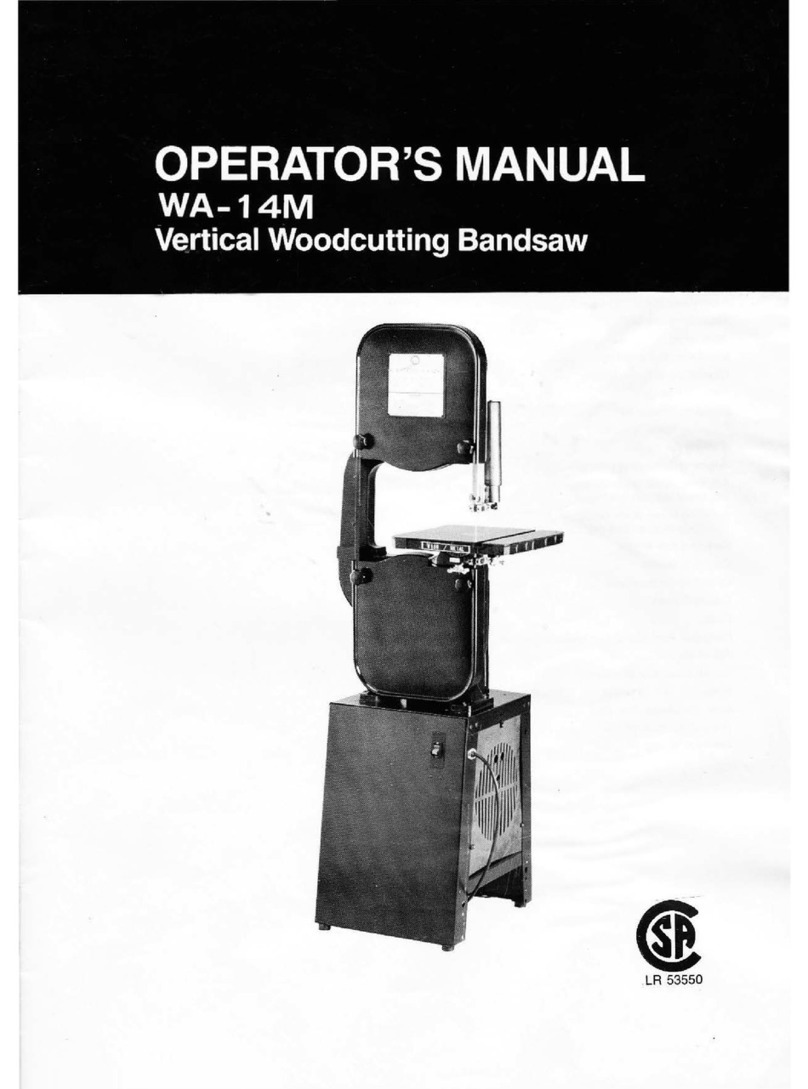stayer SC305IW User manual

www.grupostayer.com
ES
GB
Manual de instrucciones
Operating instructions
Área Empresarial Andalucía - Sector 1
C/ Sierra de Cazorla, 7
28320 - Pinto (Madrid) SPAIN
Email: sales@grupostayer.com
Email: info@grupostayer.com
SC305IW

2
9
7
3
1

11
4
10b
10a
8
5
6

ESPAÑOL
4
4
1
2
MODELO SC 305 IW
W 1600
min-1 3000
Kg 24
K=3 dB
LpA dB(A) 82
LWA dB(A) 99
I
TIPO DE CORTE Límite de tamaño
para la pieza mm
90º 170 x 90
45º / 90º 110 x 90
90º / 45º 170 x 60
45º / 45º 55 x 65
Mesa superior 0-50
DATOS TÉCNICOS

ESPAÑOL
5
5
Este manual es acorde con la fecha de fabricación de su
máquina, información que encontrará en la tabla de datos
técnicos de la maquina adquirida, buscar actualizaciones
de manuales de nuestras maquinas en la página web:
www.grupostayer.com
1. Uso previsto de la máquina
Funcionalmente la máquina tiene una mesa de corte in-
ferior y otra superior. Llamamos cabezal al conjunto móvil
que contiene el disco y la mesa superior.
Esta máquina ha sido proyectada única y exclusivamente
para:
1.Trabajar estacionariamente sobre supercie plana y es-
table.
2. Trabajar sobre piezas de maderas duras y blandas.
3. Trabajar sobre piezas de tableros de conglomerado.
4. Trabajar sobre piezas de tableros de bras.
5. Trabajar sobre piezas de tubo de PVC.
6. Realizar cortes rectilíneos a lo largo y ancho de la pieza
a trabajar.
7. Realizar cortes a inglete horizontal entre -45º y 45º.
8. Realizar cortes a inglete vertical entre 90º y 45º.
Consulte los límites de tamaño de pieza en el apartado
i2 (pág. 4).
2. Desembalado y ensamblado
Desembalado
1. Abrir la caja cortando el precinto.
2. Retirar los topes de cartón superiores.
3. Extraer la máquina de la caja, sujetando rmemente la
cabeza operadora y el cuerpo del motor, utilizando ambas
manos para equilibrar el peso.
4. Extraer la caja de accesorios.
5. Extraer la documentación.
6. Conservar permanentemente la caja de cartón, sus
topes, la caja de accesorios y la documentación en un
ambiente seguro, inventariado, de fácil acceso y conocido
por el operador de la máquina.
Embalado
Operación 1: Asegurar, plegar y jar la cabeza opera-
dora, para ello:
1. Poner el cabezal superior a 0º horizontales.
2. Poner el cabezal superior a 90º verticales.
3. Colocar el protector de forma que haga contacto en la
mesa de corte.
4. Bajar el cabezal a tope, presentándolo y bloquearlo.
Operación 2: Embalar la máquina.
1. Localizar la caja de cartón y sus rellenos de embalaje.
2. Localizar la documentación.
3. Sujetar rmemente la máquina por la cabeza operado-
ra y el cuerpo del motor.
4. Depositar la maquina sobre las hendiduras del relleno
de embalaje.
5. Depositar la documentación de la máquina.
6. Colocar los rellenos de embalaje.
Cerrar la caja jándola con precinto.
3. Establecimiento o jación de la
herramienta en una posición estable
1. Obligatoriamente el puesto de trabajo en el que se im-
planta la máquina debe ser seguro.
2. Apoyar la herramienta en posición estable sobre una
supercie plana.
3. La base de la ingleteadora dispone de los cuatro ori-
cios jar sólidamente la máquina al banco de trabajo. Se
recomienda jar la máquina al banco mediante los corres-
pondientes tornillos y tuercas.
4. Conexión a la alimentación, cableado,
fusibles, tipo de base para la clavija y
requisitos para la toma de tierra
1. Para alimentar la máquina conectar la clavija schuko a
una toma reglamentaria capaz de suministrar como míni-
mo 2500VA.
2. La máquina tiene su cableado interno completamente
terminado por lo que no necesita cableado alguno de ins-
talación.
3. La máquina no lleva fusibles, aunque se recomienda
el uso de un interruptor magnetotérmico dedicado como
protección de la máquina.
4. La máquina dispone de un equipo eléctrico de cate-
goría I, por lo que no hace uso de la toma de tierra de la
instalación eléctrica.
5. Sólo conecte la máquina en una intalación certicada y
hecha por un instalador autorizado.
5. Descripción ilustrada de las funciones
1. Palanca selectora de ángulo de mesa inferior.
2. Bloqueo del cabezal de corte.
3. Bloqueo mesa inferior.
4. Pomo de bloqueo del cabezal abajo.
5. Ajuste de límite de bajada de disco.
6. Inserción de soporte de corte largo.
7. Inserción de mordazas.
8. Pomo selector de inclinación del cabezal.
9. Bloqueo pulsador puesta en marcha.
10a. Bloqueo mesa superior.
10b. Bloqueo mesa superior.
11. Regulador altura mesa superior.
6. Limitaciones sobre las condiciones
ambientales
El grado IP de esta máquina eléctrica es 20. Esta máquina
esta protegida contra acceso a partes peligrosas con un
dedo y contra los cuerpos sólidos extraños de 12’5 mm de
diámetro y mayores. Esta máquina eléctrica no tiene nin-
guna clase de protección contra la penetración del agua
por lo que se prohíbe su uso en condiciones ambientales
exteriores o interiores con riesgo de precipitación.

ESPAÑOL
6
6
7. Lista de Contenidos
1. Uso previsto de la máquina.
2. Desembalado y ensamblado.
3. Establecimiento o jación de la herramienta en una po-
sición estable.
4. Conexión a la alimentación, cableado, fusibles, tipo de
base para la clavija y requisitos para la toma de tierra.
5. Descripción ilustrada de las funciones.
6. Limitaciones sobre las condiciones ambientales.
7. Lista de contenidos.
8. Ajustes y ensayos.
9. Cambio de herramienta.
10. Fijación de la pieza a trabajar.
11. Límites sobre el tamaño de la pieza de trabajo.
12. Instrucciónes generales sobre utilización.
13. Extracción de polvo.
14. Instrucciones de mantenimiento y servicio.
15. Garantía.
16. Eliminación.
17. Características técnicas.
18. Declaración de conformidad.
8. Ajustes y ensayos
¡Advertencia!
Antes de cualquier intervención en la herramienta eléctri-
ca, sacar el enchufe de red de la toma de corriente.
Si la máquina ha estado sometida a un uso prolongado
o intenso es necesaria su vericación y ajuste para ase-
gurar la correcta calidad de servicio y la seguridad de la
máquina.
Para ello se requiere conocimientos, experiencia y herra-
mientas especiales. El servicio técnico ocial de Stayer
Iberica S.A. realizará para usted este trabajo de manera
rápida, concienzuda y económica.
Ajuste del enclavamiento en posición de reposo
inferior
Vericación
1. Levantar el cabezal apretando el botón 2.
2. Bajar el cabezal hasta hacer tope.
3. Presionar el botón 4. Si esta bien ajustado el perno del
botón debe entrar suavemente hasta hacer tope. En caso
contrario procédase al ajuste.
Ajuste
1. Aojar el tornillo de jación del tornillo de retención 5.
2. Bajar el cabezal hasta el tope inferior.
3. Apretar o aojar el tornillo 5hasta que el pomo 4pe-
netre a tope suavemente.
4. Mientras se retiene el tornillo apretar la tuerca de reten-
ción perpendicular.
Vericación del ángulo de inglete horizontal a
± 45º
1. Desplazar el cabezal horizontalmente hasta que se en-
clave a +45º.
2. Ponga una escuadra (45º) entre el disco y el tope de
corte.
3. Vericar que los ángulos horizontales marca exacta-
mente 45º.
4. Repetir la misma secuencia para el ángulo horizontal
a -45º.
Vericación del ángulo de inglete vertical a 90º
y 45º
1. Liberar el ajuste vertical del cabezal aojando 8.
2. Mover el cabezal hasta el tope izquierdo (+45º) o cen-
tral (90º). Use 8para liberar +45.
3. Comprobar el ángulo mediante un patrón angular debi-
damente calibrado o un goniómetro (precisión mínima
± 5’) presentando una sus las supercies en la mesa infe-
rior y la otra en el disco de corte.
9. Cambio de herramienta
¡Atención!
Usar obligatoriamente discos según EN 847-1 originales
STAYER.
Cambio del disco de corte
1. Levante el resguardo protector del disco bajando el ca-
bezal.
2. Retenga el disco de corte apretándolo contra un taco
de madera y aoje el tornillo del disco girando a derechas.
3. Extraiga el disco e instale el nuevo siguiendo en modo
inverso los dos apartados anteriores.
10. Fijación de la pieza a trabajar
Siempre que sea posible se sujetará la pieza con el palo
de empuje normativo, de manera que no intervenga la
mano.
Durante el corte, sujetar la pieza establemente contra el
apoyo.
DEBEN USARSE LAS MORDAZAS SUMINISTRADAS.
Para evitar la deformación de las piezas durante la jación
se aconseja utilizar unos perles de madera, fácilmente
aplicables a las mandíbulas móviles de las mordazas.
Las mordazas se instalan en los agujeros 7.
Para cortar piezas largas en condiciones seguras, es in-
dispensable sujetarlas con los soportes adicionales, alo-
jados en los dos agujeros 6 de los ancos de la mesa
inferior. Una vez extendidas jelas con su tornillo situado
en la mesa.
11. Límites sobre el tamaño de la pieza de
trabajo
Límites de trabajo para todos los modelos incluidos en el
presente manual. Ver i2 (pág. 4).

ESPAÑOL
7
7
12. Instrucciones generales de utilización
¡Advertencia!, Debe:
1. Si la máquina está en mal estado o carece de piezas,
incluyendo los resguardos reglamentarios superiores
(puede usar las ilustraciones del presente manual como
guía orientativa) No use la máquina. Desconéctela, retíre-
la del puesto de trabajo y envíela inmediatamente a un
servicio técnico autorizado.
2. Conocer y cumplir todas las medidas de seguridad an-
tes de arrancar la máquina.
- Uso obligatorio de sistema de aspiración de partículas
cuando se corta madera.
ARRANQUE Y PARADA DE LA MÁQUINA
¡Advertencia!
1. Evitar siempre que sea posible el enclavamiento del
motor.
2. No dejar nunca desatendida la máquina en funciona-
miento.
3. Jamás arranque con el disco bloqueado y antes de co-
menzar el corte siempre esperar a que el disco de corte
alcance la velocidad máxima.
4. Antes de parar la máquina el disco debe estar despeja-
do y girando libremente.
Puesta en marcha con el pulsador manual (mesa in-
ferior).
Presionar el pulsador rectangular del mango pulsando
previamente 2para accionar el motor.
Parada de la máquina accionada con el pulsador ma-
nual (mesa inferior).
Dejar de presionar el pulsador rectangular.
Puesta en marcha con el pulsador manual (mesa su-
perior).
Presionar el pulsador rectangular del mango y bloquearlo
pulsando 9.
Parada de la máquina accionada con el pulsador ma-
nual (mesa superior).
Accionar de nuevo el pulsador rectangular para desblo-
quearlo.
Operación de corte
¡Advertencia!
1. Respete los límites de tamaño y material de la pieza a
trabajar.
2. Siempre que sea posible utilice mordazas y el palo de
empuje para sujetar la pieza a trabajar.
3. Para piezas grandes o propicios use los extensores.
Corte con la mesa inferior
¡Advertencia!
Subir a tope la mesa superior para cortar con la mesa
inferior. Actúe sobre 10a y 10b para subirla con 11.
1. Ajuste el ángulo deseado con 1y/o 8.
2. Arranque la máquina según lo explicado y espere que
se estabilice la velocidad.
3. Proceda al corte desplazando el cabezal y avanzando
suavemente.
Corte con la mesa superior
¡Advertencia!
1. Por seguridad, asegúrese de colocar el protector del
disco en la mesa inferior.
2. Arranque y accione la máquina según lo explicado.
13. Extracción de polvo
La maquina viene preparada para la aspiración de par-
tículas generadas en el corte con una salida en la parte
trasera del cabezal.
Use un aspirador con el adaptador suministrado.
14. Instrucciones de mantenimiento y
servicio
14.1 Mantenimiento y limpieza
¡ADVERTENCIA!.
Desenchufar la clavija antes de llevar a cabo cualquier
ajuste, reparación o mantenimiento.
Limpieza
Límpiese la máquina empezando con un pincel o brocha
para desalojar los restos de serrín y un paño suave.
Si se dispone de aire comprimido es recomendable na-
lizar la limpieza soplando la máquina herramienta con la
pistola de aire comprimido.
Mantenimiento
Cada 2.000 horas de uso o cada dos años la herramien-
ta eléctrica debe enviarse al servicio técnico ocial para
mantenimiento y revisión completa.
Antes de cada uso revise tuercas y uniones para detectar
cualquier aojamiento por vibración y uso. Si existen hol-
guras lleve la máquina al servicio técnico.
Salvo aprietes y revisión, la máquina no necesita de nin-
gún mantenimiento especial por parte del usuario. Man-
tenga limpia y haga un uso correcto de la máquina. Veri-
que regularmente la corrección de los ajustes autorizados
a un usuario con formación suciente. En el caso de cual-
quier fallo o duda póngase en contacto con nuestro ser-
vicio técnico.

ESPAÑOL
8
8
Lubricación
La máquina no necesita de ninguna lubricación especíca
por parte del usuario. La lubricación especíca de la he-
rramienta eléctrica se hará en las revisiones periódicas de
mantenimiento en el servicio técnico ocial.
Si a pesar de los esmerados procesos de fabricación y
control, la herramienta eléctrica llegase a averiarse, la re-
paración deberá encargarse a un servicio técnico autori-
zado para herramientas eléctricas STAYER.
Para cualquier consulta o pedido de piezas de repuesto
es imprescindible indicar el nº de artículo que gura en la
placa de ca racterísticas de la herramienta eléctrica.
14.2 Servicios de reparación del fabricante o
agente comercial
Stayer Ibérica S.A.
Área Empresarial de Andalucía - Sector 1
C/ Sierra de Cazorla, 7. CP.28320
Pinto (Madrid) Spain.
15. Garantía
Tarjeta de Garantía
Entre los documentos que forman parte de la herramienta
eléctrica encontrara la tarjeta de garantía. Deberá relle-
nar completamente la tarjeta de garantía aplicando a esta
copia del ticket de compra o factura y entregarla a su re-
vendedor a cambio del correspondiente acuse de recibo.
¡NOTA! Si faltara esta tarjeta pídasela de inmediato a su
revendedor.
La garantía se limita únicamente a los defectos de fabri-
cación o de mecanización y cesa cuando las piezas ha-
yan sido desmontadas, manipuladas o reparadas fuera
de la fábrica.
16. Eliminación
Recomendamos que las herramientas eléctricas, acceso-
rios y embalajes sean sometidos a un proceso de recupe-
ración que respete el medio ambiente.
¡No arroje las herramientas eléctricas a la basura!
Sólo para los países de la UE:
Conforme a la Directiva Europea 2012/19/
UE sobre aparatos eléctricos y electrónicos
inservibles, tras su transposición en ley na-
cional, deberán acumularse por separado
las herramientas eléctricas para ser someti-
das a un reciclaje ecológico.
Reservado el derecho de modicación.
17. Caracteristicas técnicas
= Potencia.
= Revoluciones en vacío.
= Peso.
LpA = Nivel de presión acústica.
L WA = Nivel de potencia acústica.
= Clase Protección.
Estos datos son válidos para una tensión nominal de [U]
230/240 V ~ 50/60 Hz. Los valores pueden variar para
otras tensiones y en ejecuciones especícas para ciertos
países.
18. Declaración de conformidad
El que suscribe: STAYER IBERICA, S.A.
Con dirección:
Calle Sierra de Cazorla, 7
Área Empresarial Andalucía - Sector 1
28320 PINTO (MADRID)
Tel.: +34 91 691 86 30
Declaramos bajo nuestra responsabilidad, que el pro-
ducto descrito bajo “Datos técnicos” está en conformi-
dad con las disposiciones de las directivas 2006/42/EC,
2014/30/EU, 2011/65/EU, inclusive sus modicaciones y
está en conformidad con las siguientes normas:
EN 61029-1, EN 61029-2-11, EN 55014-1, EN 55014-2,
EN 61000-3-2, EN 61000-3-3, EN 50581.
Fdo.: Ramiro de la Fuente
Director General
Junio de 2019.

ENGLISH
9
9
This manual is consistent with the date of manufacture of
your machine, you will nd information on the technical
data of the machine acquired manual check for updates
of our machines on the website: www.grupostayer.com
1. INTENDED USE
This tool has been solely and exclusively provided for:
1. Stationary works on at and stable surface
2. Working on hard and soft wooden pieces
3. Working on chipboard pieces
4. Working on berboard pieces
5. Working on PVC tubes
6. Making rectilinear cuts along the length and width of the
workpiece
7. Making horizontal mitre-cuts between -45º and 45º.
8. Making vertical mitre-cuts between 90º and 45º
Refer to the limits regarding the size of the workpiece in
corresponding chapter 11.
2. Unpackaging and assembling
Unpackaging
1. Cut the seal and open the box.
2. Withdraw upper cardboard stoppers
3. Extract the box by rmly grasping the operating head
and the motor body using both hands so as to balance
the weight
4. Extract the box with the accessories
5. Extract the documentation
6. Preserve the cardboard box, the stoppers thereof and
the documentation permanently in an inventoried safe en-
vironment being easily accessible and known to the ma-
chine operator.
Packaging
Operation 1: Securing, folding and fastening the ope-
rating head::
1. Place upper head at horizontally 0º.
2. Place upper head at vertically 90º.
3. Arrange protector such that it contacts the cutting bench.
4. Lower head to the limit and position it to be able to lock
it with the button.
Operation 2: Packaging the machine
1. Locate the cardboard box.
2. Locate documentation.
3. Firmly grasp the machine by its operating head and mo-
tor body.
4. Place the machine over the 4 circular recesses of the
bottom of the box.
5. Store documentation of the machine.
6. Position upper cardboard stoppers.
Close the box and x it with sealing tape.
3. Setting or fastening the machine in a
stable position
1. The working area where the machine is being arranged
must mandatorily be safe.
2. Support tool in a stable position on an even surface.
3. Always use the rear support 12.
4. The base of the mitre saw has four holes for rmly fas-
tening the machine to the working bench. It is strongly re-
commended to x the machine to the bench by means of
the pertinent screws and nuts.
4. Connection to the grid, wiring, fuses,
socket type for the jack and requirements
for grounding
1. For supplying electrical power to the machine, connect
the Schuko Jack to a standard socket capable of suppl-
ying a minimum of 2500 VA .
2. The internal wiring of the machine is completely termi-
nated so that no wiring is needed when installing it.
3. The machine does not have fuses although the use of
a dedicated magnetothermal switch is recommended as a
protection for the machine.
4. The machine has a class II electrical equipment so that
it does not make use of the grounding of the electrical
installation
5. Illustrated description of functions
1. Angle selector knob.
2. Cutting disc block
3. Unblocking switch for cutting disc
4. Lowered head blocker knob.
5. Disc drop limit regulator.
6. Insertion of long cutting support
7. Insertion of clamps
8. Disc tilt limit regulator.
9. Switch on lock.
10a. Upper table lock.
10b. Upper table lock.
11. Upper table height regulator
6. Limitations regarding environmental
conditions
The IP degree of this machine is 20. This machine is pro-
tected against its dangerous parts being accessed by a
nger and against solid foreign particles having diameters
of 12’5 mm and more. This machine does not have any
kind of protection against the entry of water so that its use
in exterior or interior environmental conditions with a risk
of precipitations is forbidden.

ENGLISH
10
10
7. List of contents
1. Provided uses of the machine
2. Unpackaging and assembling
3. Setting or fastening the machine in a stable position
4. Connection to the grid, wiring, fuses, socket type for the
jack and grounding conditions
5. Illustrated descriptions of functions
6. Limitations regarding environmental conditions
7. List of contents
8. Settings and testing
9. Changing tools
10. Fixing the workpiece
11. Limits regarding the workpiece size
12. General instructions for use
13. Dust extraction
14. Regular cleaning, maintenance and greasing.
15. Warrantee.
16. Disposal.
17. Technical specications
18. Declaration of conformity
8. Settings and testing
Warning!
Before any intervention on the electrical tool remove jack
from power socket.
If the machine has been subject to prolonged or intense
use, it must be checked and adjusted so as to ensure the
machine’s correct quality of service and safety.
This requires knowledge, experience and special tools.
The ocial technical service of Stayer Iberica S.A. will ca-
rry out that work for you in a quick thorough and inexpen-
sive manner.
Adjusting the locking in the lower resting position
Verication
1. Rise the head pushing button 2.
2. Lower the head until it stops.
3. Press button 4. If it is well adjusted, the bolt of the bu-
tton should smoothly enter up to the stop. If not, proceed
to adjust it.
Adjustment
1. Loosen the fastening screw of the locking screw 5.
2. Lower the head to the lower stop.
3. Tighten or loosen screw 5until the knob 4penetrates
the stop smoothly.
4. While the screw is held, tighten the nut of the perpen-
dicular restraint.
Adjust the angle of the horizontal mitre joint to
+- 45º
Verication
1. Move the head horizontally until it is locked at +45º.
2. Verify that the horizontal angle indicator marks exactly
45º. If not, proceed to the adjustment.
3. Repeat the same sequence for the horizontal angle at
-45º.
Adjust the vertical mitre joint angle to 90º and 45º.
Verication
1. Release the vertical adjustment of the head by loose-
ning 8.
2. Move the head to the left stop (+45º) or central stop
(90º). Use 8 to release +45
3. Check the angle by means of a duly calibrated angular
template or a compass (minimum precision +-5’) presen-
ting one of its surfaces on the lower table and the other
on the cutting disc. Use light as contrast to see the ad-
justment.
9. Tool change
Warning!
It is mandatory to use discs according to EN 847-1 STAYER
originals.
Cambio del disco de corte
1. Lift the disc guard lowering the head.
2. Hold the disc by pressing it against a wooden chuck
and loosen the disc screw spinning it to the right.
3. Extract the disc from above and install the new one fo-
llowing the two previous sections in reverse order.
10. Fixing the workpiece
Whenever possible, the workpiece must be xed in such a
manner that the hand does not intervene. During the cut,
keep the workpiece xed to the support.
While cutting the piece must be steadily held.
MANDATORY CLAMP USE.
To avoid deformations of the workpieces during xing the-
reof, the use of wooden proles being easily applicable to
the movable jaws of the clamps is advised. Clamps can
be installed on 7
For cutting long workpieces under safe conditions it is es-
sential to hold them with additional supports located in the
6, once placed x them with the screws under the table.
11. Limits regarding the workpiece size
Limits as included in the present manual. Pag. 4.
12. General instructions for use
Warning!
1. Do NOT use the machine if it is in a bad condition, or
lacks parts including the prescribed upper guards (the
illustrations of the present manual may be used as an
orientative guide). Unplug it, remove it from the working
area and immediately send it to an authorized technical
service.
2. Know and comply with all safety measures before you
start the machine.

ENGLISH
11
11
- Obligatory used of aspiration particle system when cut-
ting wood.
Starting and stopping the machine
Warning!
1. Always avoid the engine interlocking.
2. Never leave the tool switched on unatended.
3. Never start the machine with the disc blocked, always
wait for the disc to reach it’s maximum speed before ma-
king any cuts.
4. Before stopping the tool the disc must be free of obsta-
cles and running freely.
Starting with the manual switch (lower table)
1. Push the rectangular power switch on the handle while
pushing 2to activate the motor.
Stopping the machine
1. Stop pushing the switch
Starting with the manual switch (upper table)
1. Push the rectangular power switch on the handle and
block it with 9to activate the motor.
Stopping the machine (upper table)
1. Push again the rectangular switch
Cutting operation
Warning!
1. Respect the limits regarding the size and material of the
workpiece.
2. Use clamps to fasten the workpiece whenever possible.
3. For cutting big pieces always use the supports.
Cut on the lower table
Warning!
Rise the upper table’s height to cut on the lower table.
Work on 10a and 10b to rise it with 11
1. Adjust the desired angle with 1and 8.
2. Start the machine as explained previously and wait un-
till the disc reaches its maximum speed.
3. Proceed to cut moving the head advancing slowly.
Cut on the upper table
Warning!
1. The lower disc ward must be placed.
2. Start the machine as explained previously and wait un-
till the disc reaches its maximum speed.
13. Extraction of dust
The machine is ready for vacuuming particles generated
in the cutting with an outlet in the back part of the head.
The supplied bag can be used or coupled to a vacuum
with the supplied adaptor.
14. Regular Cleaning, maintenance and
greasing
14.1 Maintenance and cleaning
WARNING!
Take o the plug before performing any adjustment or
maintenance comeback.
Cleaning
Clean the machine starting with a brush or with a at brush
so as to remove sawdust and with a soft cloth. If compres-
sed air is available, complete cleaning by blowing with the
compressed air pistol.
Maintenance
After each 2,000 hours of use or each two years the elec-
trical tool must be sent to the ocial technical service for
maintenance and complete revision.
Before each use, check nuts and joints to detect any vi-
bration issues and use. If there are gaps take the machine
to service.
Except squeeze and brush change, the machine does not
require any special maintenance by the user. Keep the
machine clean and use it correctly. Regularly have the
correctness of the adjustments checked by a suciently
trained user. In the case of any failure, contact our tech-
nical service.
Greasing
This machine does not require any specic greasing by
the user. Specic greasing of the electrical tool will be ca-
rried out on the occasion of the regular maintenance revi-
sions at the ocial technical service.
If despite the careful process of manufacturing and con-
trol, the electric tool breaks down, the repair should be
assigned to an authorized service technician for STAYER
electric tools.
For any consultation or request for replacement parts it is
essential that you indicate the article number that appears
on the plate of characteristics of the electric tool.
14.2 Repair service of the manufacturer or
commercial agent:
Stayer Ibérica S.A.
Área Empresarial de Andalucía - Sector 1
C/ Sierra de Cazorla, 7. CP.28320
Pinto (Madrid) Spain.
15. Warrantee
Warrantee card
You will nd the warrantee card among the documents
belonging to the tool. You must ll in the warrantee card
completely and attach a copy of the purchase ticket or
invoice thereto, and give it to your distributor against the
corresponding acknowledgement of receipt.

ENGLISH
12
12
Observation! Should this card be lacking, immediately re-
quest your distributor to furnish it.
The warrantee is limited solely to manufacturing or me-
chanization failures, and it ceases to exist when parts
thereof have been disassembled, manipulated or repaired
out of the manufacturing plant.
16. Disposal
We recommend subjecting electric tools, accessories and
packaging to a recovery process that respect the environ-
ment.
Do not throw away electric tools!
For EU countries only:
In accordance with European Directive
2012/19/UE on unserviceable electric and
electronic apparatus, after transposition into
national law, electric tools must be collected
separately to subject them to ecologic recy-
cling.
Subject to change without notice.
17. Technical specications
= Power input
= No-load speed
= Weight
LpA = Sound pressure level
L WA = Sound power level
= Protection class
The values given are valid for nominal voltages [U]
230/240 V ~ 50/60 Hz - 110/120 V ~ 60Hz. For lower vol-
tage and models for specic countries, these values can
vary. Please observe the article number on the type plate
of your machine. The trade names of the individual machi-
nes may vary.
18. Declaration of conformity
EU DECLARATION OF CONFORMITY. The undersigned:
STAYER IBERICA, S.A.
With address at:
Calle Sierra de Cazorla, 7
Área Empresarial Andalucía - Sector 1
28320 PINTO (MADRID)
Tel.: +34 91 691 86 30
We declare under our own responsibility that the
product as describe und “Technical data” is in con-
formity with the following standards or standardi-
zed documents: 2006/42/EC, 2014/30/EU, 2011/65/
EU, in accordance with the provisions in Directives:
EN 61029-1, EN 61029-2-11, EN 55014-1, EN 55014-2,
EN 61000-3-2, EN 61000-3-3, EN 50581.
Fdo.: Ramiro de la Fuente
Director General
January 2019.

NOTAS

NOTAS

Área Empresarial Andalucía - Sector 1
C/ Sierra de Cazorla, 7
28320 - Pinto (Madrid) SPAIN
Email: sales@grupostayer.com
Email: info@grupostayer.com

www.grupostayer.com
Área Empresarial Andalucía - Sector 1
C/ Sierra de Cazorla, 7
28320 - Pinto (Madrid) SPAIN
Email: sales@grupostayer.com
Email: info@grupostayer.com
This manual suits for next models
1
Table of contents
Languages:
Other stayer Saw manuals
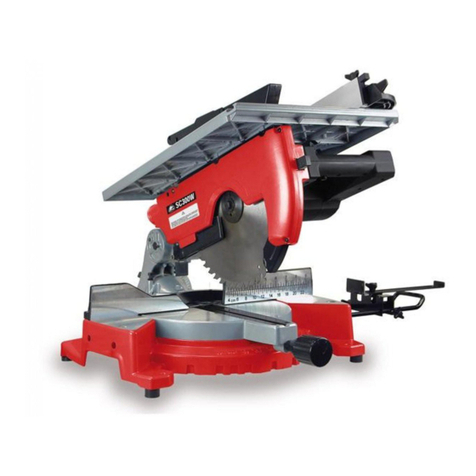
stayer
stayer SC300W User manual
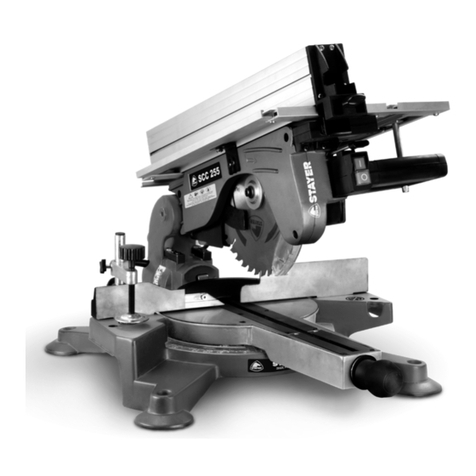
stayer
stayer SCC315 User manual

stayer
stayer SC2600W User manual
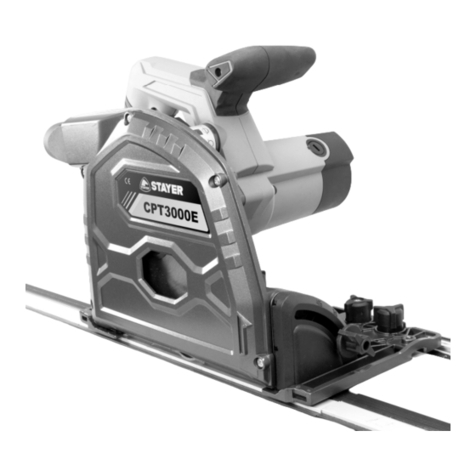
stayer
stayer CPT3000E User manual
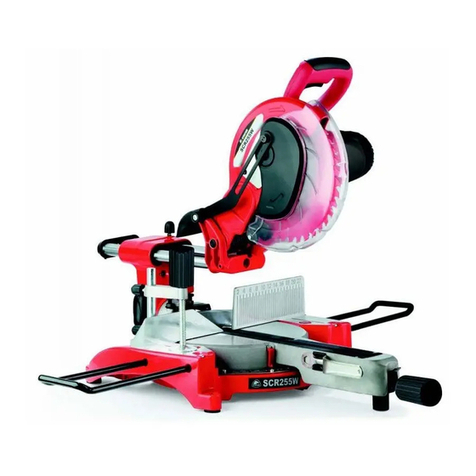
stayer
stayer SCR255W User manual

stayer
stayer CM230K User manual
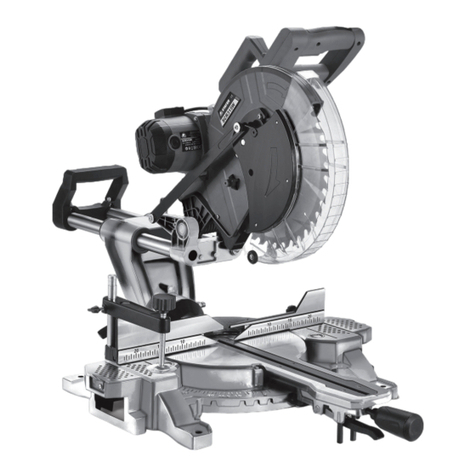
stayer
stayer SCR315W User manual
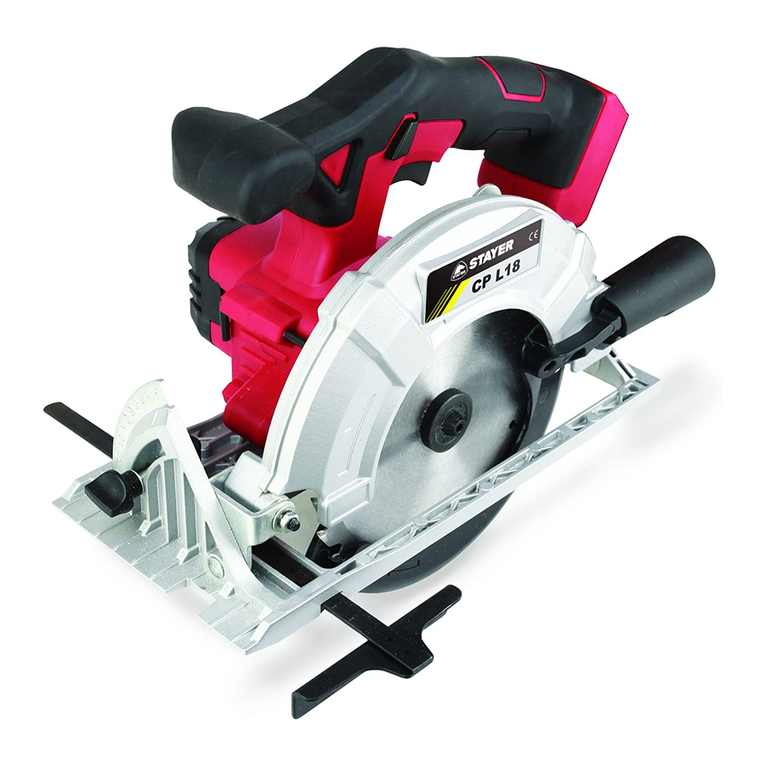
stayer
stayer CP L18 User manual
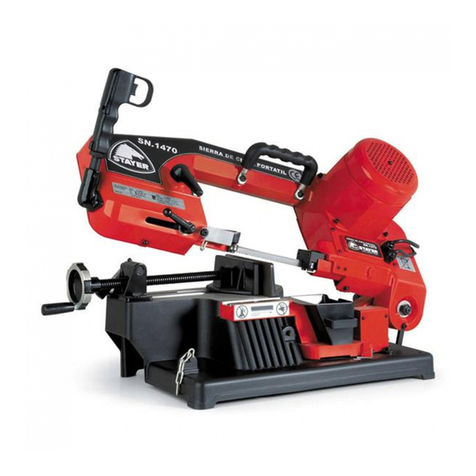
stayer
stayer SN1470 User manual

stayer
stayer MULTI L20 User manual
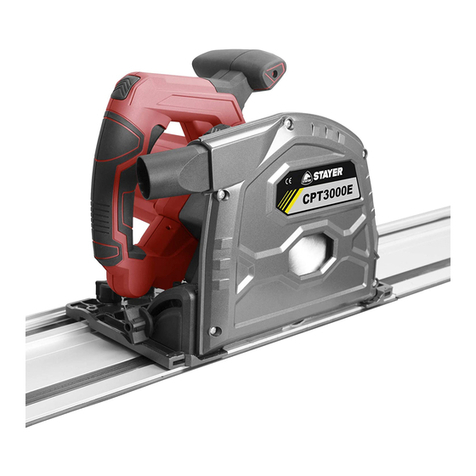
stayer
stayer CPT3000E User manual
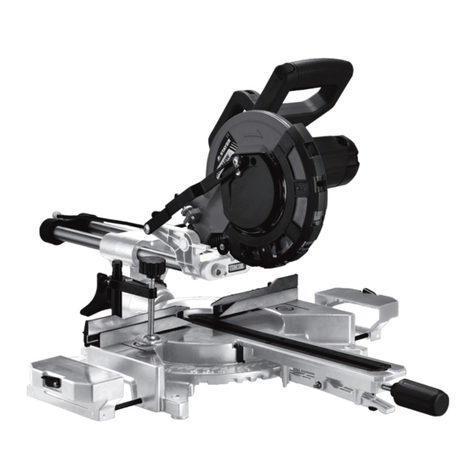
stayer
stayer SCR216W User manual
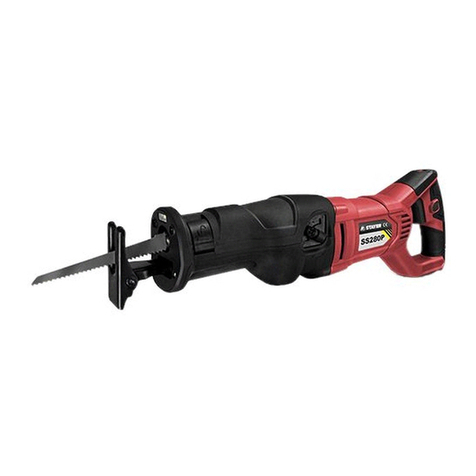
stayer
stayer SS280P User manual
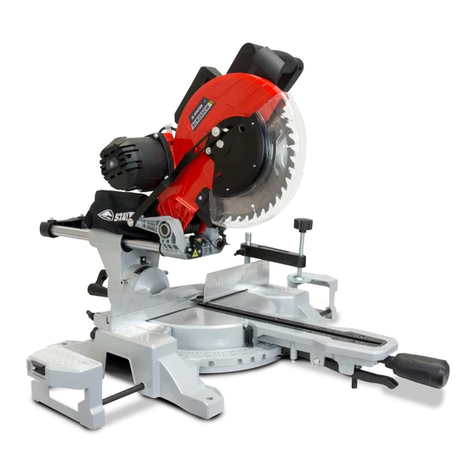
stayer
stayer SCR 255 CW User manual
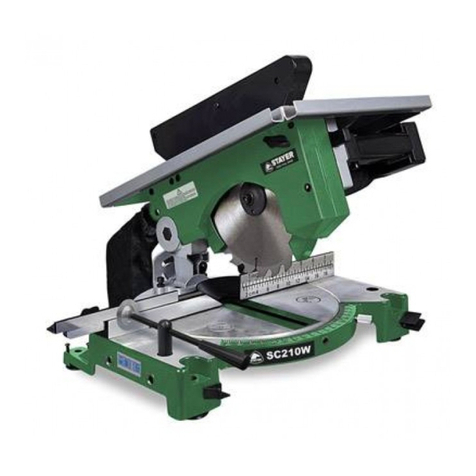
stayer
stayer SC210W User manual

stayer
stayer CP L20 User manual
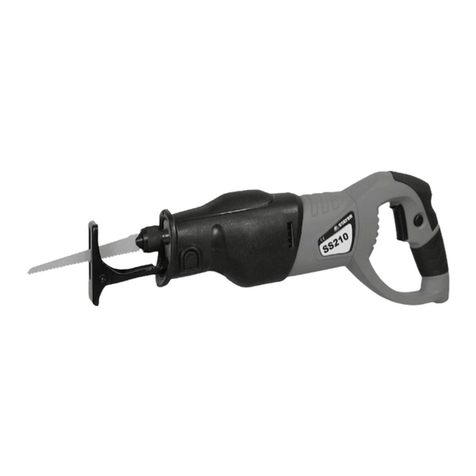
stayer
stayer SS210 User manual
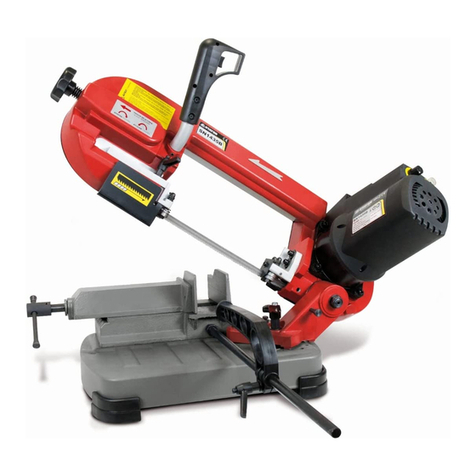
stayer
stayer SN1435B User manual

stayer
stayer SC210W User manual
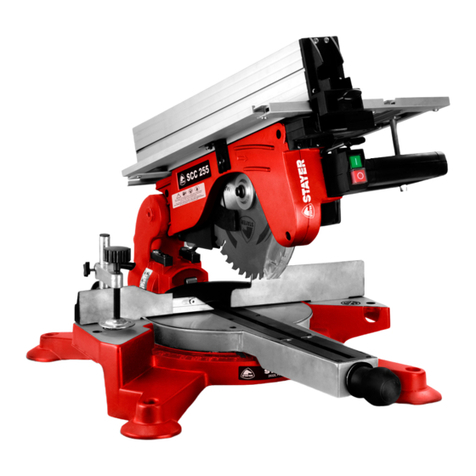
stayer
stayer SCC255 User manual
